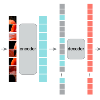Self-supervised learning has become a cornerstone in computer vision, primarily divided into reconstruction-based methods like masked autoencoders (MAE) and discriminative methods such as contrastive learning (CL). Recent empirical observations reveal that MAE and CL capture different types of representations: CL tends to focus on global patterns, while MAE adeptly captures both global and subtle local information simultaneously. Despite a flurry of recent empirical investigations to shed light on this difference, theoretical understanding remains limited, especially on the dominant architecture vision transformers (ViTs). In this paper, to provide rigorous insights, we model the visual data distribution by considering two types of spatial features: dominant global features and comparatively minuscule local features, and study the impact of imbalance among these features. We analyze the training dynamics of one-layer softmax-based ViTs on both MAE and CL objectives using gradient descent. Our analysis shows that as the degree of feature imbalance varies, ViTs trained with the MAE objective effectively learn both global and local features to achieve near-optimal reconstruction, while the CL-trained ViTs favor predominantly global features, even under mild imbalance. These results provide a theoretical explanation for distinct behaviors of MAE and CL observed in empirical studies.
翻译:暂无翻译


